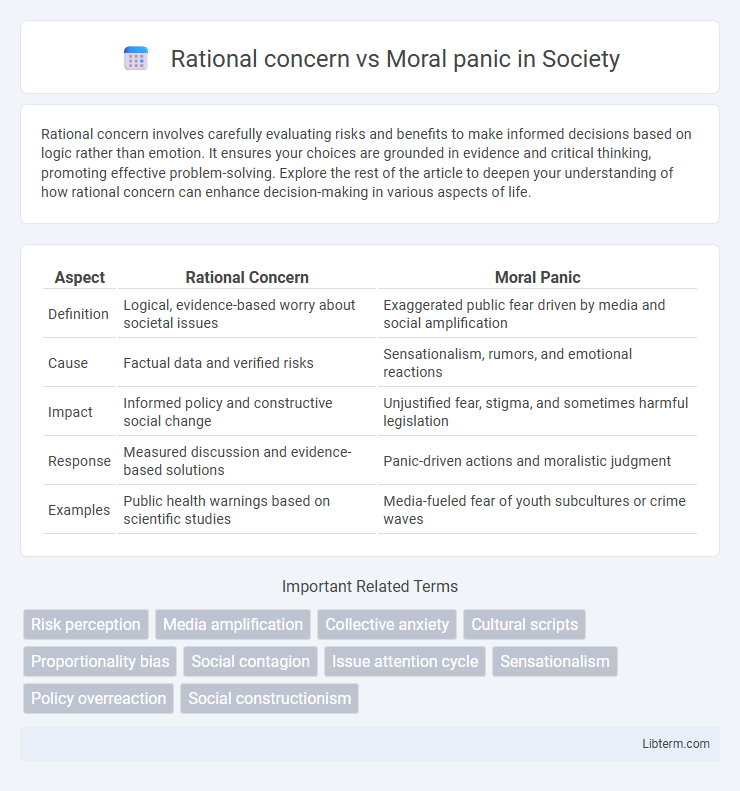Rational concern involves carefully evaluating risks and benefits to make informed decisions based on logic rather than emotion. It ensures your choices are grounded in evidence and critical thinking, promoting effective problem-solving. Explore the rest of the article to deepen your understanding of how rational concern can enhance decision-making in various aspects of life.
Table of Comparison
| Aspect | Rational Concern | Moral Panic |
|---|---|---|
| Definition | Logical, evidence-based worry about societal issues | Exaggerated public fear driven by media and social amplification |
| Cause | Factual data and verified risks | Sensationalism, rumors, and emotional reactions |
| Impact | Informed policy and constructive social change | Unjustified fear, stigma, and sometimes harmful legislation |
| Response | Measured discussion and evidence-based solutions | Panic-driven actions and moralistic judgment |
| Examples | Public health warnings based on scientific studies | Media-fueled fear of youth subcultures or crime waves |
Understanding Rational Concern and Moral Panic
Rational concern arises from evidence-based assessment and logical evaluation of potential risks or issues, reflecting informed and measured responses by individuals or groups. Moral panic, in contrast, involves exaggerated public fear driven by emotional reactions and sensationalized media coverage, often targeting specific communities or behaviors as threats to social order. Understanding the distinction between rational concern and moral panic requires analyzing the role of credible data, social context, and the influence of media in shaping public perception and policy responses.
Key Differences Between Rational Concern and Moral Panic
Rational concern arises from evidence-based assessment of real threats, characterized by proportional responses and clear risk evaluation. Moral panic involves exaggerated fear, often fueled by media amplification, leading to disproportionate social reactions and stigmatization of certain groups or behaviors. Key differences include the grounding in factual analysis for rational concern versus emotional and sensationalized responses in moral panic.
Historical Examples of Moral Panic
Historical examples of moral panic illustrate societal fear disproportionate to actual threats, such as the Salem witch trials in the 1690s, where fear of witchcraft led to mass hysteria and unjust executions. The Red Scare during the 1940s and 1950s exemplifies moral panic with widespread anxiety over communist infiltration resulting in blacklisting and infringement on civil liberties. Unlike rational concern, which is based on evidence and proportional response, moral panic magnifies perceived dangers through media sensationalism and social amplification.
Signs of Legitimate Societal Concerns
Signs of legitimate societal concerns include evidence-based data, consistent harm patterns, and expert consensus indicating real risks to public well-being. These concerns are often supported by transparent communication, ongoing research, and proportionate policy responses that address underlying issues without exaggeration. Clear differentiation from moral panic arises when responses are measured, rational, and grounded in factual societal impacts rather than fear-driven sensationalism.
Media’s Role in Fueling Moral Panic
Media often amplifies moral panic by sensationalizing events and emphasizing fear-inducing narratives, which can distort public perception compared to rational concerns based on evidence. Sensational headlines and repetitive coverage create a feedback loop that escalates anxiety and prompts disproportionate social or political responses. This phenomenon highlights the media's power to shape societal reactions beyond objective risk assessment.
Psychological Triggers Behind Public Reactions
Rational concern arises from evidence-based assessment of risks and potential harm, engaging critical thinking and informed judgment. Moral panic is driven by psychological triggers such as fear, uncertainty, and the need for social cohesion, often amplified by media and authoritative figures. These emotional responses provoke amplified public reactions that can lead to disproportionate measures beyond the actual threat level.
The Impact of Moral Panic on Policy Making
Moral panic significantly distorts policy making by amplifying public fear through sensationalized media coverage, leading to reactionary laws that may lack empirical support or proportionality. Policymakers influenced by moral panic often prioritize short-term political gains over evidence-based solutions, resulting in ineffective or overly punitive measures that fail to address underlying social issues. This dynamic undermines rational concern, which advocates for data-driven, balanced approaches in developing sustainable and just public policies.
Managing Collective Anxiety: Promoting Rational Responses
Managing collective anxiety involves distinguishing rational concerns, based on evidence and proportional risks, from moral panic, which often stems from exaggerated fears and misinformation. Effective communication strategies emphasize transparency, provide factual information, and engage trusted community leaders to foster informed public responses. Prioritizing critical thinking and emotional support helps reduce irrational fears and promotes balanced decision-making during crises.
Case Studies: Rational Concerns Misinterpreted as Panic
Case studies demonstrate that rational concerns, such as public health warnings about vaccine side effects, are often misinterpreted as moral panic due to media sensationalism and social media amplification. Instances like the 2010 swine flu outbreak highlight how legitimate epidemiological data triggered disproportionate fear, leading to stigmatization and policy overreactions. Analysis of social responses in these events reveals the critical need for clear communication to differentiate evidence-based risk from exaggerated moral alarm.
Building Resilience Against Unfounded Social Fears
Rational concern is grounded in evidence-based analysis of risks, while moral panic arises from exaggerated social fears often fueled by misinformation. Building resilience against unfounded social fears requires critical thinking, media literacy, and community engagement to distinguish credible threats from sensationalized narratives. Strengthening public understanding of facts helps prevent panic-induced disruptions and promotes informed decision-making.
Rational concern Infographic

 libterm.com
libterm.com